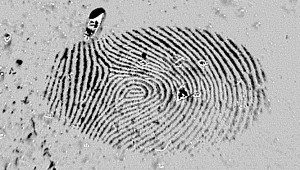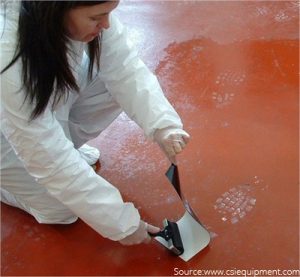
Crime scene technicians worldwide are using “Gel Lifter” to visualize prints in special cases, e.g. strongly bend surfaces (edge of a cup), strongly textured surfaces (nubby bottles) or cut edges (inside of a can), for a few years already.
Gel lifters are systems where (usually black) polymer carrier gels with high cohesion impact are placed onto the trace substance. When applied, first the protective foil is removed from the gel surface, before the gel foil is pressed and fixed onto the area of interest and removed again. This process causes the trace material to be lifted from the exhibit to a great extend due to the adhesive effect of the lifter. Also, the geometrical structure is transferred.
This is followed by a fettling of the foil which includes a certain degree of equalization of the trace image. Afterwards, the foil is scanned, usually applying a special “foil scanner” which utilizes a blue or UV-light and makes use of the diffusion on the pulled off trace material.
 Originally, they were developed to secure shoeprints.
Originally, they were developed to secure shoeprints.
In the broadest sense, gel lifters are used to complement optical investigation methods.
With EVISCAN and its IR-technology, it is possible to secure gel lifter prints of fatty prints with high contrast and to make half-fatty prints at least visible. If the EVISCAN IR-technology is applied to latent prints which have already been lifted by gel lifter, the securing of fatty, half-fatty and latent prints is possible even afterwards. Thus, the EVISCAN technology either replaces the gel lifter examination or is embedded in the workflow of securing latent prints – in cases in which the gel lifer examines e.g. complicated geometries.
However, in all of the described cases EVISCAN is the only option to detect and secure latent prints.



